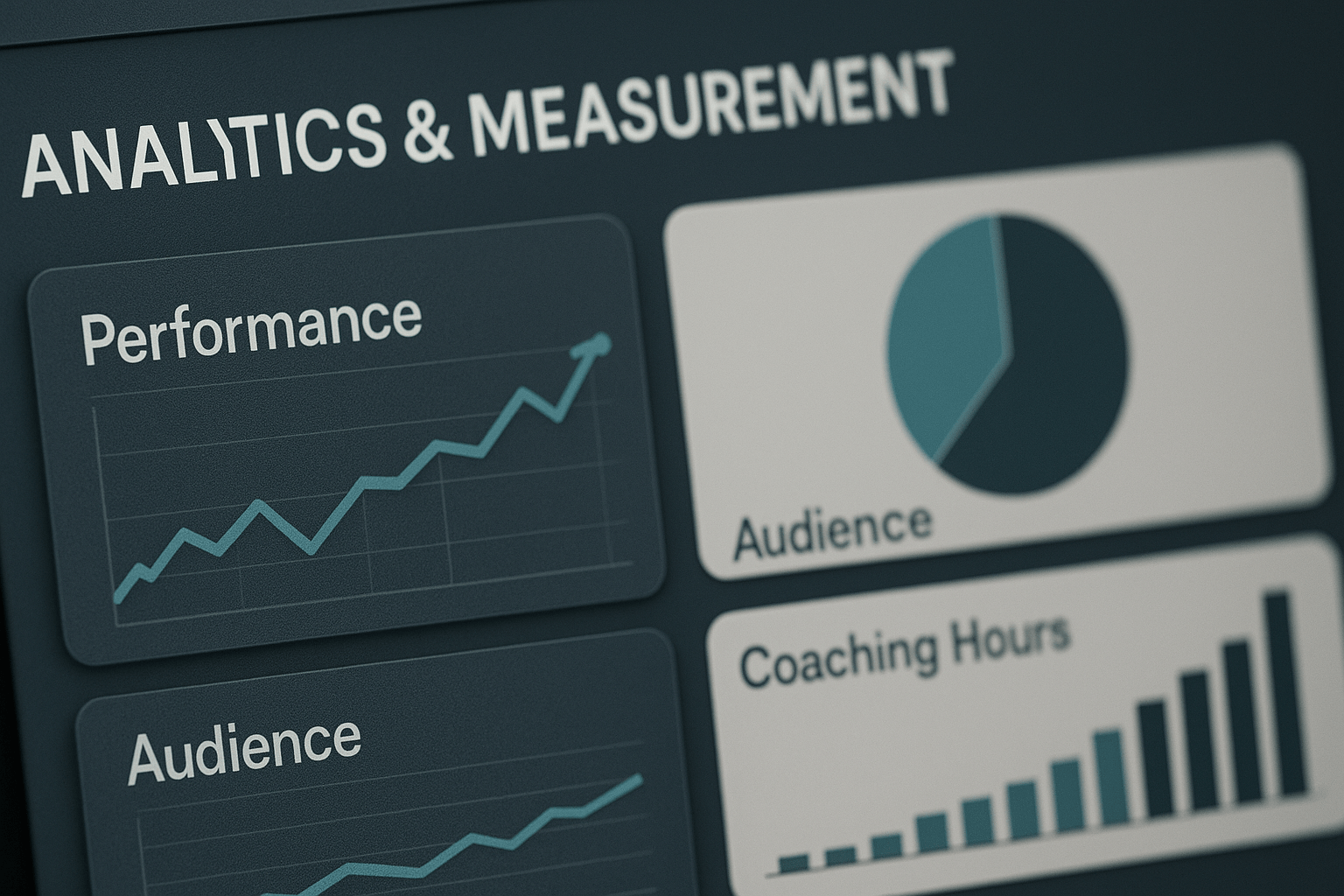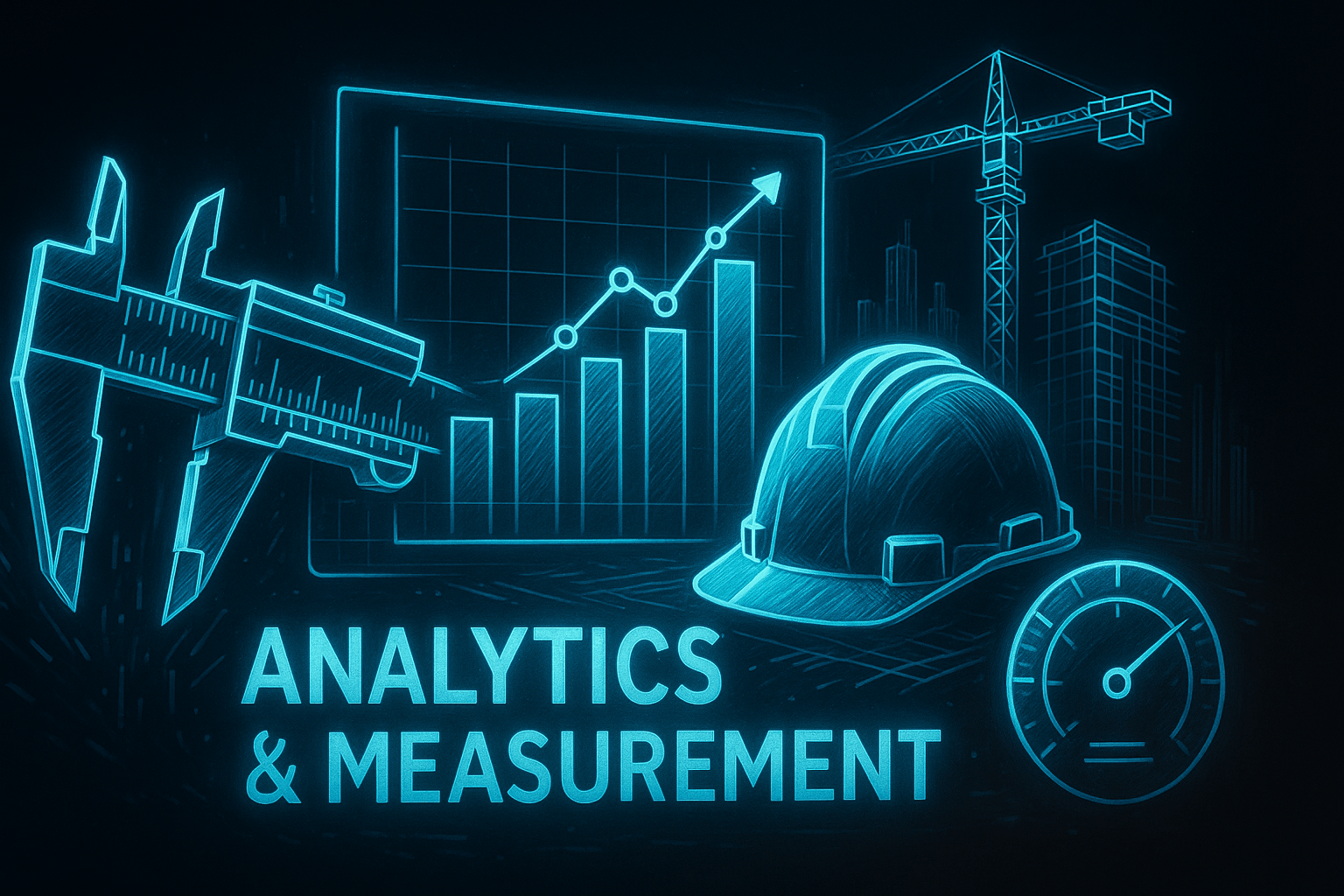Analytics & Measurement for Physical Therapy: Data-Driven Patient Acquisition & Revenue Growth
by Design Delulu Editorial · September 26, 2025

Smart, fast, and measurable. Here's how analytics & measurement helps Physical Therapy win.
Physical therapy clinics operate in an increasingly competitive healthcare landscape where patient acquisition costs continue rising while insurance reimbursements remain under pressure. Without reliable analytics and measurement systems, clinic owners make marketing decisions blind—wasting budget on ineffective channels, missing high-intent referral opportunities, and failing to connect online engagement to actual appointment bookings. The clinics that thrive understand exactly which marketing efforts drive new patient inquiries, which referral sources deliver the highest lifetime value, and where to allocate next quarter's growth budget.
Analytics and measurement matters because physical therapy success depends on predictable patient flow and sustainable unit economics. When you can track the complete journey from initial search query through appointment scheduling to treatment completion, you gain the intelligence needed to scale profitably. This means implementing tracking systems that connect your website analytics to scheduling software, attribution models that credit the right touchpoints, and dashboards that surface actionable insights without requiring a data science degree. The practices investing in proper measurement infrastructure today are building compounding advantages that competitors without clean data simply cannot replicate.

Why Physical Therapy Clinics Need Specialized Analytics
Physical therapy practices face unique measurement challenges that generic analytics setups fail to address. Your patient acquisition funnel includes multiple stakeholders—referring physicians, insurance verification staff, treatment coordinators, and the patients themselves—each requiring different tracking approaches. Traditional ecommerce analytics assume linear purchase paths, but physical therapy journeys involve research phases that span weeks, consultation calls that happen offline, and insurance verification steps that create conversion lag between initial inquiry and confirmed appointment.
The best physical therapy analytics systems account for these complexities by tracking phone call conversions separately from form submissions, attributing value to educational content that nurtures patients through decision-making, and connecting online behavior to your practice management software. This means implementing server-side tracking to capture data even when browsers block cookies, building custom events that fire when high-intent actions occur (like clicking directions or downloading insurance information), and creating cohort analyses that reveal which marketing channels produce patients with the highest treatment adherence and lifetime value.
Beyond acquisition metrics, specialized analytics help physical therapy practices optimize clinical operations and resource allocation. By measuring appointment show rates by referral source, treatment completion rates by condition type, and revenue per patient by acquisition channel, you identify operational bottlenecks and strategic opportunities that basic website analytics miss entirely. Clinics using comprehensive measurement discover that certain insurance plans deliver unprofitable patients, specific service pages convert at 5x the site average, or particular geographic areas represent untapped growth markets worth dedicated campaigns.
Core Components of Effective Physical Therapy Measurement
A robust analytics foundation for physical therapy requires four integrated layers working together: event tracking infrastructure, visualization dashboards, attribution modeling, and data governance protocols. Each component serves distinct purposes while feeding data into a unified system that supports both tactical optimization and strategic planning.
Event Tracking & Data Collection
Modern physical therapy analytics begins with comprehensive event tracking that captures every meaningful interaction across your digital properties. This extends far beyond basic pageview data to include form submissions (consultation requests, insurance verification forms, contact inquiries), phone call events (click-to-call from website, tracked phone numbers by campaign), engagement actions (video plays, PDF downloads, location map interactions), and conversion milestones (appointment scheduled, new patient intake completed, treatment series booked).
Implementing this requires Google Analytics 4 with enhanced event tracking, server-side tag management to ensure data accuracy despite browser privacy measures, integration bridges connecting your practice management software to analytics platforms, and call tracking systems that attribute phone conversions back to original marketing sources. The investment in proper tracking infrastructure pays dividends immediately—clinics typically discover that 30-60% of conversions happen via phone calls that previously went unmeasured, dramatically changing their understanding of which marketing channels actually work.
Dashboards & Reporting Systems
Raw data becomes actionable intelligence through well-designed dashboards that surface the metrics driving physical therapy growth. Your dashboard architecture should include an executive overview showing patient acquisition costs, conversion rates, and revenue by channel at weekly intervals; campaign performance views breaking down individual initiatives by spend, leads, cost per acquisition, and patient lifetime value; and operational dashboards tracking appointment slots filled, no-show rates, treatment completion percentages, and referral source performance.
Looker Studio (formerly Google Data Studio) serves as the backbone for most physical therapy analytics dashboards because it connects directly to GA4, integrates with practice management software through APIs or database connections, updates automatically without manual data exports, and allows customization for different stakeholders (marketing staff see campaign metrics, clinic managers see operational KPIs, ownership reviews financial performance). Building these dashboards requires upfront design work to determine which metrics matter most, but saves countless hours previously spent compiling manual reports while ensuring everyone makes decisions from the same trusted data source.

Attribution Modeling
Physical therapy patient journeys rarely follow simple paths—prospects might find your clinic through organic search, revisit via Facebook ad, call after seeing a billboard, then convert after a physician referral. Attribution modeling determines how credit gets assigned across these touchpoints, fundamentally shaping which marketing channels appear successful and where you invest future budget.
For physical therapy practices, position-based attribution models (giving 40% credit to first and last touch, 20% to middle touches) often reflect reality better than last-click models that ignore the awareness-building work earlier touchpoints perform. Custom attribution that gives extra weight to physician referrals, adjusts for offline touchpoints captured through intake forms, and accounts for multi-location dynamics where patients research one clinic but book at another provides even more accurate insights for practices with the data infrastructure to support it.
Data Governance & Quality Control
Analytics systems degrade over time without active governance—tracking breaks after website updates, spam submissions pollute conversion data, team members create redundant reports with conflicting numbers, and nobody knows which dashboard represents truth. Establishing data governance means documenting your tracking plan (what gets measured, how events fire, what each metric means), implementing quality checks that alert when data looks abnormal, maintaining a single source of truth that everyone references, and scheduling quarterly audits to verify tracking accuracy.
This governance layer prevents the data decay that turns analytics from trusted advisor to ignored noise. Practices with strong governance catch problems immediately (like tracking code accidentally removed during a website update), maintain stakeholder confidence in reported numbers, and make faster decisions because nobody wastes time reconciling different reports or questioning data accuracy.
Implementation Roadmap for Physical Therapy Analytics
Deploying comprehensive analytics follows a structured approach that balances quick wins with foundational work required for long-term success. This phased methodology ensures your practice starts seeing value within weeks while building toward sophisticated measurement capabilities.
Phase 1: Discovery & Goal Setting (Week 1-2)
Begin by clarifying what success looks like for your practice and which metrics directly connect to business objectives. This discovery phase involves stakeholder interviews with clinic owners, practice managers, and marketing leaders to understand current pain points, defining 3-5 primary KPIs that will guide optimization efforts, documenting your existing tech stack (website platform, practice management software, marketing tools), and mapping the complete patient journey from awareness through treatment completion.
The output from discovery is a measurement strategy document that specifies which data gets collected, how different systems integrate, what dashboards get built, and which success metrics determine if the analytics implementation succeeded. Spending adequate time in discovery prevents expensive rework later when you realize critical data sources got overlooked or important stakeholder needs went unaddressed.
Phase 2: Blueprint & Architecture Design (Week 2-3)
With strategy defined, the blueprint phase designs the technical architecture and measurement plan. This includes creating your tracking plan spreadsheet listing every event, parameter, and conversion to be measured; designing dashboard mockups showing how data will be visualized for different users; planning GA4 configuration including custom events, conversions, and audience definitions; mapping API integrations between analytics platforms and practice management software; and documenting attribution logic and reporting cadences.
The blueprint serves as the implementation guide for the build phase and the reference document for ongoing maintenance. Quality blueprints account for edge cases (how to handle patients calling multiple locations, tracking patients who book online but call to cancel, attributing value to educational content without direct conversion), making the actual build faster and more reliable.
Phase 3: Build & Launch (Week 3-6)
Implementation brings the blueprint to life through systematic deployment and testing. This phase includes installing GA4 with server-side tagging for reliable data collection, configuring custom events for physical therapy-specific actions, building integrations between analytics and practice management systems, creating Looker Studio dashboards with automated data connections, implementing call tracking with proper attribution, and conducting thorough QA across devices, browsers, and user scenarios before launch.
Proper QA catches issues before they corrupt your data—test every form submission, verify phone call tracking fires correctly, confirm that practice management data flows into dashboards accurately, and validate that events fire on mobile devices and tablets that patients commonly use. Launch with parallel running (keeping old systems active temporarily) to verify new tracking captures everything the old approach did while adding new capabilities.

Phase 4: Optimization & Iteration (Ongoing)
Analytics implementation doesn't end at launch—the optimization phase extracts ongoing value from your measurement system. This includes weekly dashboard reviews to spot trends and anomalies, monthly deep-dives analyzing specific channels or campaigns, A/B testing informed by analytics insights, attribution model refinements as you learn which touchpoints truly drive value, and quarterly audits ensuring tracking remains accurate as your website and marketing evolve.
The practices that maximize analytics ROI treat measurement as a continuous improvement process rather than a one-time project. They build optimization sprints into their quarterly planning, train staff on how to interpret dashboards and take action on insights, and maintain documentation so knowledge doesn't leave when team members transition.
Industry-Specific Best Practices for Physical Therapy
Physical therapy practices that excel at analytics share common approaches tailored to healthcare's unique dynamics. These proven practices accelerate results while avoiding pitfalls that trip up clinics new to data-driven marketing.
Map Measurement to Patient Journey Stages
Structure your analytics around how patients actually find and choose physical therapy providers. Early-stage awareness (general searches like 'knee pain relief' or 'physical therapy near me') requires different tracking than mid-funnel evaluation (comparing clinic reviews, checking insurance acceptance, reviewing specialties) and late-stage conversion (clicking directions, calling to schedule, submitting new patient forms). Tag content and campaigns by journey stage so you can measure which initiatives build awareness versus which close conversions, allocate budget appropriately across the funnel, and identify drop-off points where patients disengage.
Prioritize Phone Call Attribution
Unlike ecommerce where most conversions happen through trackable online forms, physical therapy sees 50-70% of new patient conversions start with phone calls. Implement call tracking that uses unique phone numbers for different marketing sources (website, Google ads, Facebook campaigns, direct mail), records calls for quality assurance, captures caller information for CRM integration, and attributes calls back to the digital touchpoints that preceded them. Without phone tracking, you'll systematically undervalue channels that drive call conversions while overinvesting in channels that only generate form fills.
Connect Analytics to Practice Management Data
Website analytics tell you who visited and inquired; practice management software knows who actually became a patient and their lifetime value. Connecting these systems reveals which marketing sources deliver profitable patients versus expensive tire-kickers. Build integrations that flow scheduled appointment data back into analytics platforms, tag patients by acquisition source in your practice management system, calculate revenue by channel incorporating treatment adherence and episode length, and measure quality metrics like no-show rates and treatment completion by referral source. This closed-loop measurement transforms marketing from a cost center into an accountable growth driver.
Establish Single Source of Truth Dashboards
Nothing undermines analytics faster than multiple stakeholders looking at different dashboards showing conflicting numbers. Designate one official dashboard set as your source of truth, train all users on how to access and interpret these dashboards, schedule recurring reviews (weekly tactical, monthly strategic) using these dashboards, and deprecate or clearly label exploratory analysis dashboards to avoid confusion. When disagreements arise about performance, having a trusted single source of truth prevents analysis paralysis and keeps teams executing.
Implement Incremental Testing Methodology
Analytics enables hypothesis-driven optimization, but ambitious physical therapy practices sometimes launch too many changes simultaneously, making it impossible to determine what actually drove results. Adopt a disciplined testing approach that changes one variable at a time when possible, runs tests for sufficient duration to reach statistical significance (usually 2-4 weeks for most clinics), documents test hypotheses and results in a shared tracker, and compounds winning tests into standard operating procedures. Small, validated improvements compound into transformative results over 6-12 months.
Common Pitfalls & How to Avoid Them
Physical therapy analytics implementations frequently stumble over predictable obstacles. Recognizing these pitfalls upfront helps you navigate around them.
Analysis Paralysis from Too Many Metrics
When everything is measured, nothing gets improved. Clinics drowning in data but starved for insights typically failed to identify their vital few metrics—the 3-5 KPIs that actually matter for business success. Combat this by establishing a hierarchy: North Star metrics (overall patient acquisition cost, revenue per new patient), primary metrics (conversion rate, cost per lead by channel), and supporting metrics (everything else). Review North Star metrics weekly, primary metrics monthly, supporting metrics quarterly or on-demand only.
Broken Tracking After Website Updates
Website redesigns, platform migrations, and even minor updates frequently break tracking implementation, creating data gaps that compromise historical comparisons. Prevent this by including analytics verification in your website change checklist, maintaining staging environments where you test tracking before production deployment, documenting exactly where tracking code lives and how it's implemented, and setting up automated alerts that notify you when conversion rates drop anomalously (suggesting tracking broke).
Ignoring Data Quality Issues
Spam form submissions, internal traffic in analytics, bot-generated pageviews, and test transactions pollute data, distorting your understanding of what's working. Implement filters to exclude internal IP addresses, establish bot filtering, create form validation that blocks obvious spam, and regularly audit conversion data for suspicious patterns. Clean data costs more upfront but saves exponentially more downstream when you make confident decisions instead of second-guessing whether the numbers reflect reality.
Underestimating Integration Complexity
Connecting analytics platforms with practice management software, phone systems, and marketing tools sounds straightforward but often involves API limitations, custom development, or middleware solutions that expand timeline and budget. Scope integrations conservatively during planning, prioritize integrations by value (start with highest-impact data flows), build fallback plans for manual data bridging when automated integration proves impractical, and remember that imperfect data available immediately beats perfect data arriving too late to inform decisions.
Measuring Analytics ROI for Physical Therapy
Analytics implementations require investment in platforms, implementation services, and ongoing maintenance. Justifying this investment means quantifying returns in terms practice owners understand: increased revenue, decreased waste, and improved operational efficiency.
The direct financial return comes from better marketing allocation—stopping spend on channels with poor patient LTV, increasing budget on high-performing sources, and identifying expansion opportunities worth dedicated campaigns. Practices typically see 15-30% improvement in marketing efficiency within the first year of implementing comprehensive analytics, essentially paying for the measurement system through reduced waste alone. Indirect returns include operational improvements discovered through data (optimizing appointment scheduling to reduce no-shows, identifying service lines with highest profitability, recognizing staffing patterns that impact patient experience), competitive advantages from faster optimization cycles than competitors working without good data, and strategic clarity that comes from knowing exactly which initiatives drive business growth.
Measure your analytics ROI by tracking marketing cost per patient acquisition before and after implementation, calculating the value of patients from previously unmeasured channels (usually phone conversions), quantifying waste eliminated by stopping ineffective campaigns, and documenting operational improvements enabled by measurement insights. Most practices find the system pays for itself within 3-6 months while delivering compounding returns over multi-year horizons.
Getting Started: Your Next Steps
Implementing analytics and measurement for your physical therapy practice begins with honest assessment of your current state and clear prioritization of where to start. Conduct an analytics audit evaluating what's currently tracked, how accurate that data is, and which gaps create the biggest blind spots in your decision-making. From there, prioritize foundational infrastructure (reliable event tracking, call attribution, basic dashboards) before pursuing advanced capabilities, and consider whether to build internal expertise, hire specialized agencies, or blend both approaches based on your budget and timeline.
The practices that succeed with analytics share a commitment to data-informed decision-making and patience to build capabilities systematically rather than expecting overnight transformation. Start small, validate your tracking, build trust in the data, then expand your measurement sophistication as the foundation proves reliable. The competitive advantages compound over time, creating sustainable moats that competitors without clean data cannot easily replicate.
Frequently Asked Questions
Let’s level up your Physical Therapy business
Need services that actually move the needle for Physical Therapy? See our approach, pricing, and timelines—then book a quick call.
Additional Resources
- Schedule Your Analytics Consultation
Book a 30-minute consultation to discuss your physical therapy practice's measurement needs. We'll review your current analytics setup, identify gaps in your tracking infrastructure, and outline a customized implementation roadmap with transparent pricing, timelines, and expected ROI.
- View Our Physical Therapy Portfolio
Explore case studies and results from our physical therapy analytics implementations. See real-world examples of tracking setups, dashboard designs, and measurement strategies that helped clinics reduce patient acquisition costs and scale profitably across multiple service lines and locations.
- Free Analytics Tools & Resources
Access our library of free tools designed for physical therapy marketing teams. Download tracking plan templates, dashboard blueprints, KPI calculators, and implementation checklists that help you build measurement infrastructure even before engaging an analytics agency.
Related Reading

Transform property management with advanced analytics. GA4 setup, attribution modeling, dashboards & tracking plans. 4-8 week implementation. See pricing & deliverables.

Implement powerful analytics & measurement systems for e-learning & creators. Track student engagement, course performance, and revenue metrics with GA4, dashboards, and attribution modeling.
